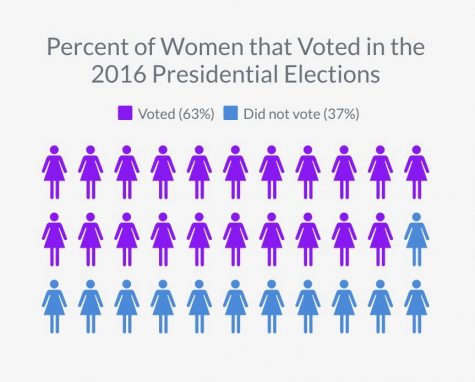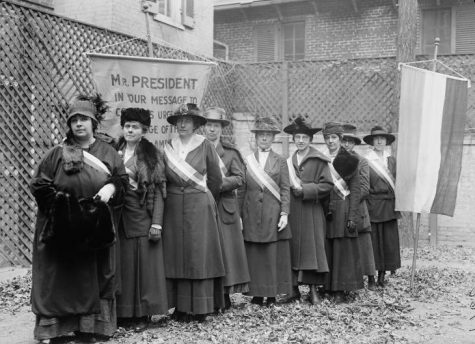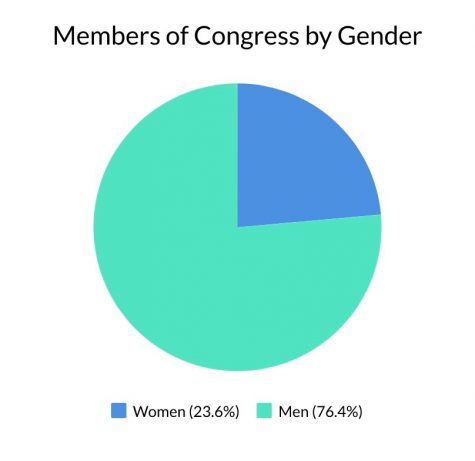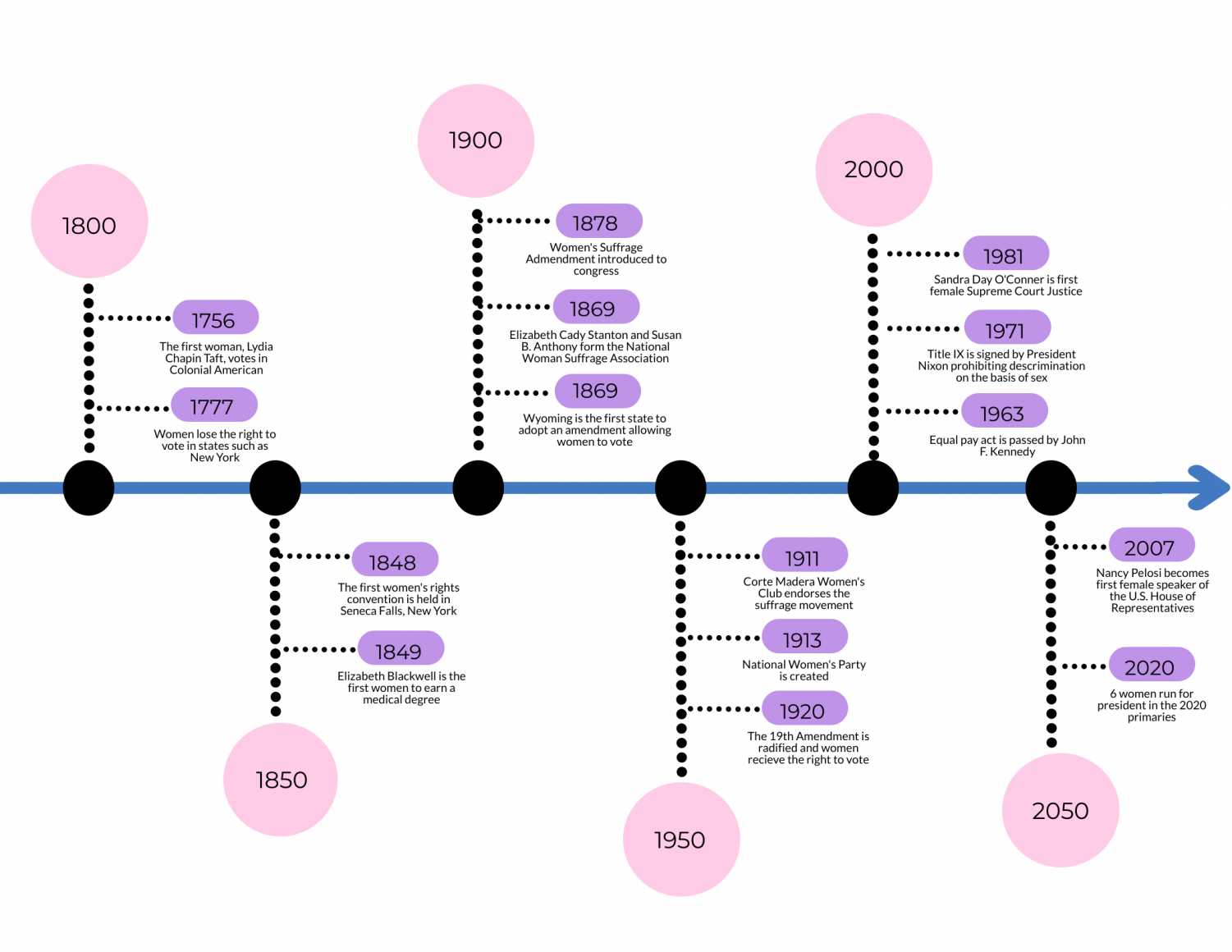On August 18, 1920, almost 100 years ago, the 19th Amendment to the Constitution was ratified by Congress granting women the right to vote. This achievement was the result of over 70 years of protests and strikes as part of the women’s suffrage movement. The revolutionary movement was led by the National American Woman Suffrage Association and its leaders, Elizabeth Cady Stanton and Susan B. Anthony. The accomplishments of these women continue to influence politics and gender equality today.
Stanton laid the foundation that allowed the suffrage movement to thrive. She wrote inspiring speeches and conducted research that fueled the movement. Anthony, who had a similar view to Stanton, said that “there never will be complete equality until women themselves help to make laws and elect lawmakers.”

Ann Jaime is a women’s history and U.S. history teacher at Redwood. Jaime claims that the leaders who fought for women’s rights changed elections permanently as they allowed women’s voices to be heard in our democracy.
“[Women] were more than half the population statistically and [they] were denied the right to vote. If you wanted to make the U.S. a true democracy, you had to enfranchise women. A hundred years ago it was even more important to give women some sort of power over their own destiny,” she said. “At the end of the day, I feel like the women who really pressed Congress to add the amendment sacrificed so much of themselves so my life could be better. And for that reason, I think [voting] is a really important right that we enjoy and should exercise,” Jaime said.
The women’s suffrage movement was not only prominent in Washington DC. According to local historian and former Corte Madera mayor, Jana Haehl, women had a large impact locally.
“Women really were the backbone of the community. Everything that happened, happened because of women,” Haehl said.
When people initially began to settle down and build homes in Marin in 1906, the Women’s Club, an organization still active in the community today, was founded to help bring the community together. In 1907, the town of Corte Madera’s first street lights were paid for by the Women’s Club. Following their first project, the Women’s Club built a park surrounding the central train station in less than two weeks, and then later, paved Main Street to create downtown Corte Madera.
Haehl believes that the club’s most impactful actions were the small ones that allowed the community to function as it does today. The club endorsed women’s equality in local organizations such as the sanitation board and the 1915 World Fair.
“What I think are the real accomplishments of the [Women’s Club] are the things they did that people didn’t particularly notice at the time, but that we see now, were really pivotal,” Haehl said.
The Women’s Club was also vocal in the fight for women’s suffrage. In 1911, the club formally endorsed the suffrage movement and created a Franchise League in order to support the cause. One of the biggest advocates for the suffrage movement in Marin was Elizabeth Thacher Kent. The Kent family, which Kent Woodlands, Kentfield and Kent Middle School were named after, was a prominent family in the community. Elizabeth’s husband, William, was a member of the U.S. House of Representatives from 1911 to 1917.

While living in Washington DC, Elizabeth Kent became inspired by the suffrage movement. She joined the National American Woman Suffrage Association and became the leader of their Congressional Committee. Elizabeth advocated for women’s rights at the 1913 and 1914 conventions of the National American Woman Suffrage Association, and she was instrumental in the creation of the Women’s Party which pressured the U.S. President at the time, Woodrow Wilson, into creating equal voting rights for men and women. Elizabeth participated in several marches and was even arrested multiple times for expressing her beliefs. Following her death in 1952, Elizabeth was inducted into the Marin Women’s Hall of Fame for her local and national roles in women’s equality and the fight for suffrage.
Elizabeth was especially influential in Marin because of her family’s local prominence, which gave her a platform to raise awareness and share her ideas. Elizabeth frequently stood on Tamalpais Drive in Corte Madera giving speeches and expressing her beliefs.
Laurie Thompson is a local librarian who has researched the local women’s suffrage movement. Thompson is inspired by Elizabeth’s courage, persistence, and willingness to stand up for her beliefs.
“[Elizabeth] was way ahead of her time in so many ways. She fought her whole life for women’s rights and she inspires me. I want to tell her story,” Thompson said. “She never stopped; she continued on this path for her entire life.”
Thompson believes that even though Elizabeth has passed the baton along, the movement is still strong. She hopes that we will soon achieve complete gender equality, something Elizabeth fought for over 100 years ago.
“We’re at a moment in our society where women are still trying to break through the glass ceiling and she was doing this a hundred years ago. I’m extremely inspired by that,” Thompson said.
The actions of suffrage activists such as Elizabeth paved the way for female voters to exercise their rights and impact politics. Since 1964, a higher percentage of women have voted than men. According to the Center for American Women and Politics, in the 2016 elections, almost ten million more votes were cast by women than men, and the number of votes cast by women reached a record high at 73.7 million.
Even though progress has been made, Caitlin Kulperger, the co-president of the Junior State of America Club at Redwood, believes that it is still important for women to get more involved in politics.

“I think that [women] bring a different perspective to the table that could lead to big changes for our country,” Kulperger said. “You see more female politicians, you see more female leaders throughout our country. We still have further to go, but I think that if we establish young girls and young students from an early age that they’re able to lead as well, I think that’s huge.”
Though women’s rights have increased dramatically since the early 1900s, there is still inequality between men and women, especially in the workplace. According to the Center for American Progress, women earn the majority of doctorates but only 32 percent of those women become college professors. According to Catalyst, an organization that strives to create gender equality in the workplace, only 29 percent of senior management positions are held by women. Additionally, 5 percent of CEOs are women and only 11 percent of women in senior management positions are the highest earners of their companies.
In the future, Haehl hopes to see the number of female CEOs grow as fast as the number of women in government.
“I think the more women are in decision making roles, the more they’ll be able to bring other women up through the ranks,” Haehl said.
Historic change has happened this year, with a record-breaking number of female presidential candidates in the 2020 primaries. Six women were originally running for president for the Democratic Party: Elizabeth Warren, Kamala Harris, Amy Klobuchar, Kirsten Gillibrand, Tulsi Gabbard, and Marianne Williamson. Although all of these women have since dropped out, there is still hope that a woman will take on a major leadership position in the next administration. On March 15, Joe Biden, the leading candidate in the Democratic primaries, pledged to select a woman as his running mate if he wins the Democratic Party’s nomination.
According to the National Public Radio (NPR), in Congress, there is currently a record number of women (127), a record number of women of color (43), the first Muslim and Native American women, and the youngest female congresswoman in history. Data from the Center for American Women and Politics shows that 23.6 percent of members of Congress are female, as compared to 20 percent in 2018.
The actions taken by women such as Elizabeth Cady Stanton, Susan B. Anthony, and many more have impacted women’s involvement in politics forever. Haehl hopes that women don’t forget about the sacrifices suffragists made in order to allow them the right to vote.
“Now, people take it for granted that a woman can be whatever she wants to be, but that didn’t happen prior to the passage of the 19th amendment that gave women the right to vote. It took a long time,” Haehl said. “Women should have roles in everything, everything that they are interested in doing. And there shouldn’t be any barriers one way or another.”














